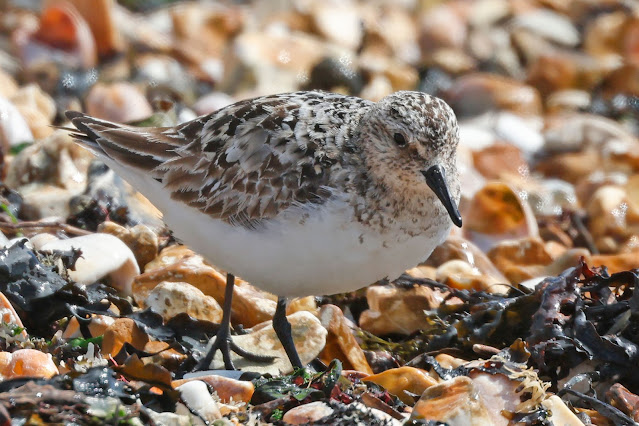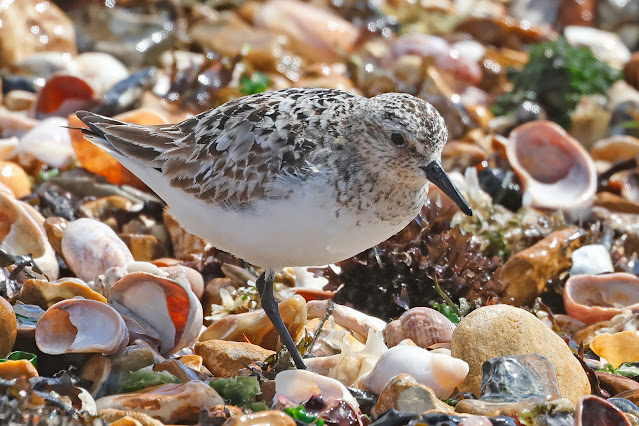A bright clear morning after some heavy rain the day before. I arrived at Bridge Street car park with Chiffchaffs calling in the bushes at the back of the car park. I set off along the canal path with the sun breaking through. More Chiffchaffs were calling in the willows and I came across this individual preening after having a bath. What stood out to me was the complete lack of tail, not something I had seen in this species before.
Checking across the floods There were a couple of Black-tailed Godwits and two Egyptian Geese. In the willows along the path a Nuthatch was calling and showed intermittently amongst the leaves.
Coming out from the Willows there was a group of cattle in front of me and in amongst them a Cattle Egret. Interestingly there had been a report this morning of 31 heading west off shore at Hill Head. I managed to get a record before it was spooked and flew to a tree. From there it was buzzed by a couple of Grey Heron and then it flew across the field and dropped down among the trees near the river.
It was difficult viewing the floods at Posbrook as the vegetation was quite high, looking across the flood the bulrushes were covered in spider webs.
I walked as far as the Little Posbrook far without much more about. Swallows were hawking around the cattle and House Martin seemed to prefer flying around the trees. Walking back I was taken by this Speckled Wood lit up by the morning sunshine and contrasting against the black background.
The view looking back towards Posbrook Floods, note the very lush vegetation around the pools, this time last year everything was either dead or yellow.
A Whitethroat showed in the bushes as I made my way back to the car park.
A little further along at about the spot where you can view the Barn Owl tree a Golden-ringed Dragonfly settled on the nettles
I wanted to be at the reserve when it opened as yesterday a Bittern was seen early from the Spurgin Hide. I drove to an empty sea wall, parked up and then went to view Duck Bay, three Common Sandpiper were feeding on the mud.
As I checked the edge of the reeds all around the bay I heard the calls of Bearded Tits and eventually found the owners at the top of the reeds.
There were seven in total and they were all female or immature birds and could be seen flying cross the top of the reeds.
On showing a little better.
As I walked to the west gate a Wheatear was sitting on the top.
I walked straight to the Spurgin Hide, and once able to get in was greeted with a lot of hot air, but nothing else. In front of the hide were a couple of Coot and a Woodpigeon and for an hour that was the sum of the watching.
With nothing seeming like it was going to happen I left and headed back towards the Meon Shore Hide. Along the path a treecreeper showed well.
It wasn't much better from the Meon Shore Hide, the water levels had gone up with the recent rain. There were two Common Sandpiper to the left of the hide and one or two Avocet about. The Common Terns were noisy and there were good numbers, with even a very young chick on one of the platforms. I took the opportunity to photograph the Common Terns as they flew around the scrape.
Not having all day I decided to try the east side, maybe there was something on the meadows. Walking along the sea wall I was taken by the yachts out on the Solent.
I could see a group of gulls on the beach behind the sailing club, so walked along the beach to check them out. They were mostly Black-headed Gulls but amongst them were one or two Mediterranean Gulls. At the back two Lesser Black-backed Gulls stood on guard.
A lone Common Tern appeared carrying a fish, it tried to land but immediately drew the attention of the gulls so flew off again.
Mediterranean Gulls were joined by other, here showing the all white plumage against the blue sea.
An adult losing the summer black hood, but still looking a very smart gull.
An opportunity to compare against the smaller Black-headed Gull, the size and shape of the bills.
I had hoped there might be a few waders on the beach and sure enough there were some Sanderling along with a good number of Turnstone. The Sanderling were a mix of fading summer plumage and the full silver grey winter plumage.
Two in their faded breeding plumage.
I needed to get better light so dropped down on to the beach. As I did so Turnstone appeared on the groyne. The background then became the sea and some sky which produced a lovely pastel background.
This one nearly in full winter plumage.
More summer plumage on this bird, I also liked the grain in the groyne which adds to the scene.
Closing in on what is a beautiful bird close up.
But as always it was about the Sanderling, first this winter plumaged bird.
But then a focus on the partial summer breeding plumage.
I know I can't resist a Sanderling at is good to have them back.
And finally a sleeping winter bird.
I reluctantly left the Sanderling and headed into the reserve's east side. I made my way to the Walkway Pond where after a little wait I was able to find the Willow Emerald once more. A different position this time showing the wings held open like a dragonfly.
There was also a couple of Ruddy Darter about. This is a male, the Ruddy Darter differed from the commoner Common Darter by the pinched abdomen and the red head.
I changed my plans to check the meadow when a report came in of a Wood Sandpiper on the causeway of the South Scrape. With not much time left I hurried around to the west side and the Meon Shore Hide. The Wood Sandpiper was still there but as reported distant, at the back of the scrape.
Not my best photographs of Wood Sandpiper but sufficient to confirm the year tick.
Hopefully there is plenty of time left in the season to get better views of Wood Sandpiper. An interesting day, nothing spectacular, but good to be out.

















































No comments:
Post a Comment